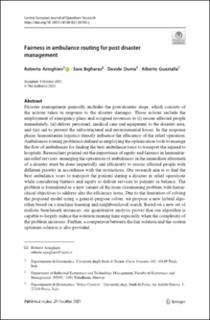| dc.contributor.author | Aringhieri, Roberto | |
| dc.contributor.author | Bigharaz, Sara | |
| dc.contributor.author | Duma, Davide | |
| dc.contributor.author | Guastalla, Alberto | |
| dc.date.accessioned | 2022-03-11T07:36:16Z | |
| dc.date.available | 2022-03-11T07:36:16Z | |
| dc.date.created | 2021-11-17T14:24:01Z | |
| dc.date.issued | 2021 | |
| dc.identifier.citation | Central European Journal of Operations Research. 2021, . | en_US |
| dc.identifier.issn | 1435-246X | |
| dc.identifier.uri | https://hdl.handle.net/11250/2984422 | |
| dc.description.abstract | Disaster management generally includes the post-disaster stage, which consists of the actions taken in response to the disaster damages. These actions include the employment of emergency plans and assigned resources to (i) rescue affected people immediately, (ii) deliver personnel, medical care and equipment to the disaster area, and (iii) aid to prevent the infrastructural and environmental losses. In the response phase, humanitarian logistics directly influence the efficiency of the relief operation. Ambulances routing problem is defined as employing the optimisation tools to manage the flow of ambulances for finding the best ambulance tours to transport the injured to hospitals. Researchers pointed out the importance of equity and fairness in humanitarian relief services: managing the operations of ambulances in the immediate aftermath of a disaster must be done impartially and efficiently to rescue affected people with different priority in accordance with the restrictions. Our research aim is to find the best ambulance tours to transport the patients during a disaster in relief operations while considering fairness and equity to deliver services to patients in balance. The problem is formulated as a new variant of the team orienteering problem with hierarchical objectives to address also the efficiency issue. Due to the limitation of solving the proposed model using a general-purpose solver, we propose a new hybrid algorithm based on a machine learning and neighbourhood search. Based on a new set of realistic benchmark instances, our quantitative analysis proves that our algorithm is capable to largely reduce the solution running time especially when the complexity of the problem increases. Further, a comparison between the fair solution and the system optimum solution is also provided. | en_US |
| dc.language.iso | eng | en_US |
| dc.publisher | Springer | en_US |
| dc.rights | Navngivelse 4.0 Internasjonal | * |
| dc.rights.uri | http://creativecommons.org/licenses/by/4.0/deed.no | * |
| dc.title | Fairness in ambulance routing for post disaster management | en_US |
| dc.type | Peer reviewed | en_US |
| dc.type | Journal article | en_US |
| dc.description.version | publishedVersion | en_US |
| dc.source.pagenumber | 23 | en_US |
| dc.source.journal | Central European Journal of Operations Research | en_US |
| dc.identifier.doi | 10.1007/s10100-021-00785-y | |
| dc.identifier.cristin | 1955594 | |
| cristin.ispublished | true | |
| cristin.fulltext | original | |
| cristin.qualitycode | 1 | |

